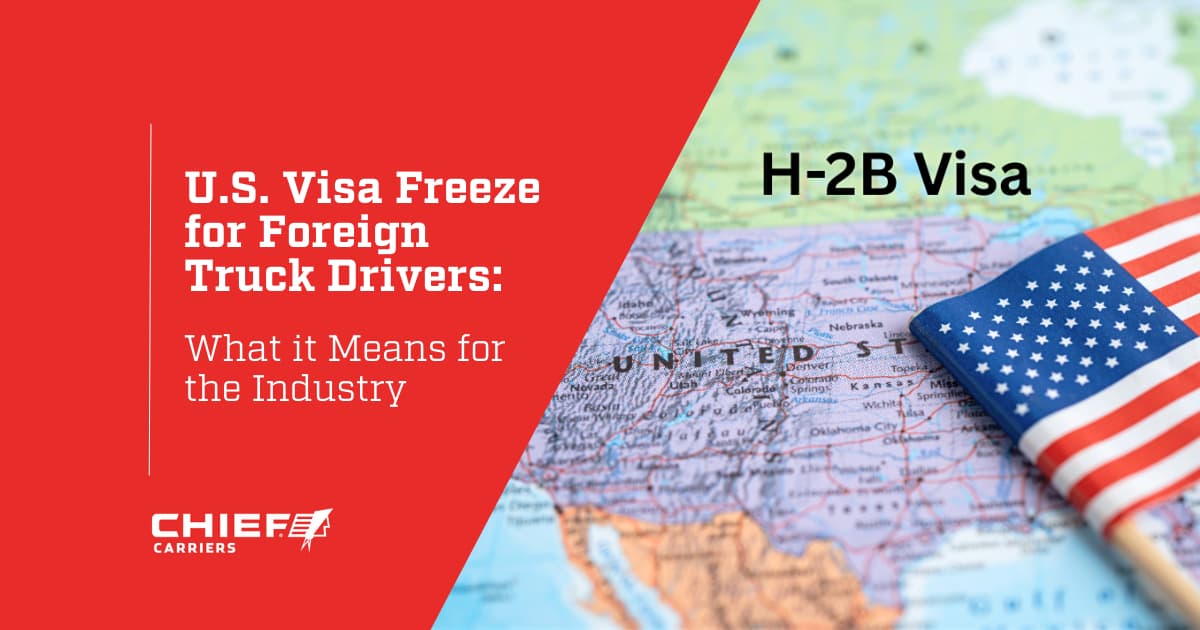How the Pause on Foreign Truck Driver Visas Could Reshape the Trucking Industry
The recent U.S. visa freeze for foreign truck drivers, particularly affecting the H-2B visa and similar programs, has significantly worsened the existing driver shortage. The State Department’s policy change directly impacts supply chain stability, as a key source of driver talent has been restricted. For companies and industry professionals, it means that building a resilient, sustainable workforce now depends more than ever on attracting and retaining top domestic talent.
At Chief Carriers, we stay informed on the issues impacting the trucking, transportation, and logistics industry. We’ll analyze the effects of the freeze on truck driver visas and detail how a driver-centric approach offers a proven solution to these new challenges.

The Visa Landscape for Immigrant Truck Drivers: A Quick Guide
Understanding the various visa types is crucial to grasping the policy’s full impact. These programs have historically provided different pathways for immigrant truck drivers to work in the United States.
H-2B Visa
This is a non-immigrant visa for temporary or seasonal non-agricultural work. Until recently, it was a common pathway for trucking companies hiring foreign drivers to fill short-term labor gaps. The recent suspension of this program for truck drivers has effectively cut off a significant source of temporary talent.
EB-3 Visa
An employment-based, third-preference immigrant visa, the EB-3 is for skilled, professional, or other workers. Unlike the H-2B, the EB-3 is a permanent, green card-based visa. While it remains an option for some, its limited availability and extensive application process make it an impractical solution for the industry’s immediate and large-scale labor needs.
Non-Domiciled CDL
A non-domiciled CDL is a commercial driver’s license issued by a state or jurisdiction to an individual domiciled in a foreign country. This designation allows drivers from specific countries to operate commercial vehicles in the U.S. under certain conditions, but it does not grant them the right to work in the country without an appropriate visa.

The US Truck Driver Visa Freeze: A Breakdown of the Impact
The visa freeze is not a theoretical concern; it is a policy change with immediate, tangible consequences for the U.S. supply chain. The ripple effects are already being felt across various sectors.
The American Trucking Associations (ATA) estimates a current shortage of over 80,000 drivers. This number is projected to surpass 160,000 by 2030. The visa freeze exacerbates this issue by removing a critical valve for talent inflow, putting immense pressure on an already strained system.
Supply Chain Implications
With fewer drivers on the road, the industry faces an unprecedented capacity crunch. This leads to:
- Increased shipping costs
- Longer transit times
- Higher risk of service disruptions for businesses and consumers alike
The stability of the entire logistics network is at risk, highlighting the systemic importance of a robust driver workforce.
RELATED: Freight Volumes vs. Truck Capacity: The Battle of Supply and Demand
Industry Expert Perspective
“Foreign drivers and non-domiciled CDLs have actually created the overcapacity issue we’re seeing today,” says Andrew Winkler, General Manager of Chief Carriers. “That excess supply of drivers is keeping freight rates artificially low, which is exactly why the market hasn’t rebounded. Until the industry takes a hard look at who’s moving freight on our highways, we won’t see a true recovery.”

Before & After: The US Truck Driver Visa Freeze Impact on Recruitment
The visa freeze has fundamentally altered the landscape for talent acquisition in the trucking industry. The shift is not a subtle change but a dramatic pivot toward a more constrained and competitive market.
RELATED: The Impact of Driver Turnover: Why Truck Driver Retention Matters

The Chief Carriers Solution: Investing in a Resilient Workforce
The current U.S. visa freeze is a significant disruption to the industry’s traditional labor pipeline, underscoring a critical challenge: a reliance on temporary solutions can leave a business vulnerable. However, for companies that have proactively invested in their domestic workforce, this new policy environment is not a crisis but a validation of a long-term strategy.
While many companies are now struggling to pivot their recruitment efforts, Chief Carriers’ commitment to a domestic workforce has always provided a robust and dependable solution to capacity issues, regardless of shifts in immigration policy.
Chief Carriers has always believed that a sustainable, resilient fleet is built by investing in professional U.S. drivers. This approach isn’t a reaction to a recent policy change. It’s a foundational business philosophy that ensures our operations remain stable, our drivers are valued, and our clients receive consistent, reliable service.
Competitive Compensation & Benefits
We offer a top-tier compensation package that includes excellent pay, bonuses, and comprehensive benefits. Our data shows that Chief Carriers’ drivers earn, on average, 15% more than the industry average for similar routes and equipment. This investment is not an expense; it’s a commitment to our drivers and a key to long-term retention.
RELATED: Navigating Truck Driver Compensation Packages: What to Look For
A Culture of Safety and Respect
We’re proud of our award-winning safety record and culture. Our driver-centric policies, including transparent communication and a commitment to work-life balance, have made us a preferred employer.
One of our drivers, Dallas Wheelock, puts it simply: “At Chief, you aren’t just a driver, you are part of a family. Here, the CEO takes the time to talk to you as a person, which makes you feel like you are a part of something, and I am proud to be a part of that.”
RELATED: Chief Carriers Named Among 2025 List of Best Fleets to Drive For
Advanced Training & Support
We offer state-of-the-art training and continuous support, from initial orientation to advanced safety courses. Our professional development programs ensure that drivers not only have a job but also a long-term, rewarding career path.

Can the Driver Shortage Actually Be a Good Thing?
Conventional wisdom says that a driver shortage is an existential threat to the trucking industry. However, a different perspective suggests that this crisis could be a catalyst for much-needed positive change.
The US trucking industry’s capacity issues stemming from the use of foreign drivers may prompt companies to innovate and enhance working conditions for their domestic workforce. With a limited pool of new drivers, the focus must shift from constant, reactive recruitment to strategic retention. This requires companies to invest in better pay, benefits, and a superior work environment.
This crisis is an opportunity to strengthen the industry from within, making it more attractive and sustainable in the long run. When trucking rates are low in the US, the pressure to find an inexpensive labor solution is high; however, the long-term solution lies in a commitment to your people, not in a race to the bottom.

FAQ: Answering Your Questions About the Visa Freeze
Q: What is the current status of the H-2B visa for truck drivers?
The H-2B visa program for foreign truck drivers has been temporarily frozen, severely limiting a key source of new talent for the industry.
Q: How does the visa freeze affect my business’s supply chain?
It creates an increased strain on an already limited driver pool, which can lead to longer shipping times, higher costs, and a less reliable logistics network.
Q: Are there any other visas for truck drivers?
While some limited options, such as the EB-3 visa, remain, they are not a viable solution for the large-scale, short-term labor needs previously met by the H-2B program.
Q: What is the FMCSA truck driver English language proficiency requirement?
The FMCSA requires all commercial motor vehicle drivers to be proficient in English, regardless of their nationality, a standard that ensures safety and effective communication.

Looking Inward to a Domestic Workforce in Trucking
The US truck driver visa freeze is a pivotal moment for the industry, exposing the vulnerabilities of an over-reliance on a temporary foreign labor supply. The future of a resilient, reliable U.S. trucking industry lies not in external labor sources but in a renewed commitment to its domestic workforce. Companies that prioritize competitive compensation, outstanding working conditions, and a culture of respect will not only survive but thrive in this new landscape.
Chief Carriers is proud to have championed this model for years. We believe that by investing in our people, we are building a more stable and prosperous future for our company and the entire industry.
Contact us to learn more about our driver opportunities or to discuss your shipping needs.
To hear more on visa freezes for truck drivers from our General Manager, Andrew Winkler, listen to our Driven Too Far podcast episode, “Driver Visas on Hold: The Impact on Rates and Safety.”

